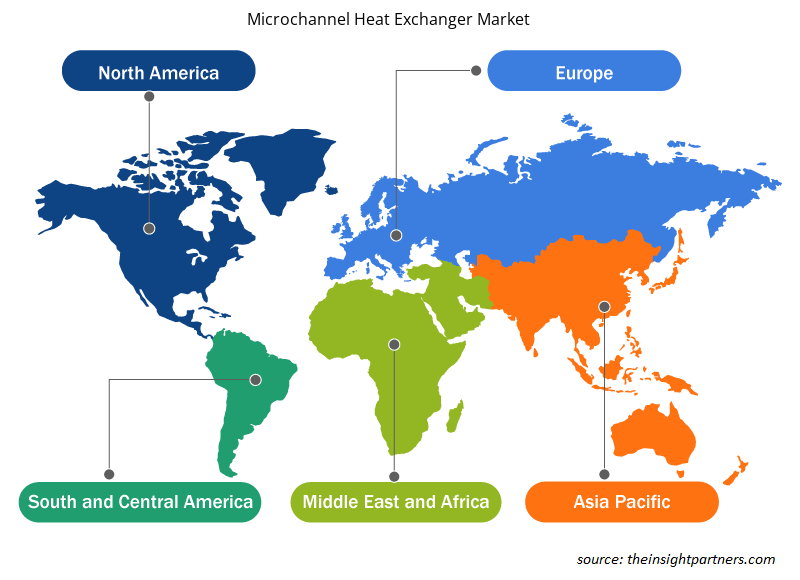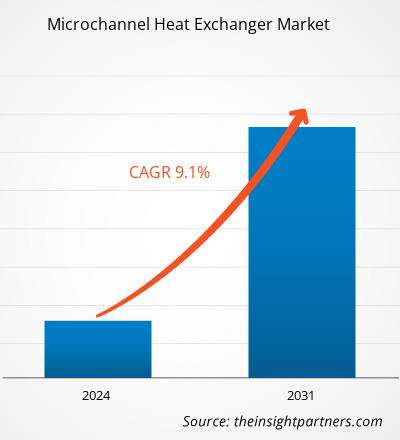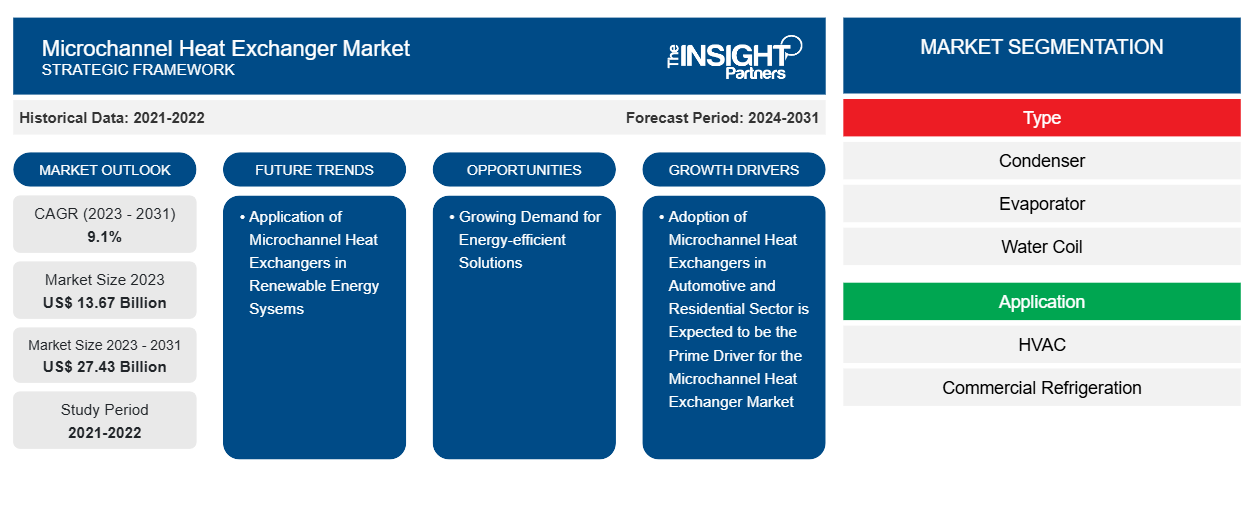من المتوقع أن يصل حجم سوق المبادل الحراري ذي القنوات الدقيقة إلى 27.43 مليار دولار أمريكي بحلول عام 2031 من 13.67 مليار دولار أمريكي في عام 2023. ومن المتوقع أن يسجل السوق معدل نمو سنوي مركب بنسبة 9.1٪ في الفترة 2023-2031. المبادل الحراري ذي القنوات الدقيقة مناسب للاستخدام في أنظمة تكييف الهواء السكنية والتجارية جنبًا إلى جنب مع معدات التبريد نظرًا لكفاءته في استخدام الطاقة وقدرته على خفض شحنات المبردات. تُستخدم المبادلات الحرارية ذات القنوات الدقيقة في المقام الأول لأغراض التدفئة والتبريد. يعمل التقدم المتزايد في صناعة السيارات كمحرك رئيسي لسوق المبادل الحراري ذي القنوات الدقيقة.
تحليل سوق المبادلات الحرارية ذات القنوات الدقيقة
يمكن استخدام المبادلات الحرارية الدقيقة في العديد من التطبيقات، على سبيل المثال، محركات الصواريخ، وشفرات التوربينات، والمركبات الهجينة، وتبريد التبريد، وتخزين الهيدروجين ، والتحكم الحراري في الجاذبية الدقيقة وحلقات المضخة الشعرية. يتغير متطلب إزالة تدفق الحرارة بشكل كبير في المقام الأول بناءً على نوع التطبيق. يلعب تطبيق المبادل الحراري الدقيق دورًا مهمًا في القضاء على تدفق الحرارة العالي من الأنظمة المدمجة مثل الثنائيات الليزرية والاندماج النووي، ورقائق الكمبيوتر عالية الأداء، ومفاعلات الانشطار لتأكيد أدائها الثابت مع عمر طويل.
نظرة عامة على سوق المبادلات الحرارية ذات القنوات الدقيقة
تُستخدم المبادلات الحرارية ذات القنوات الدقيقة في أنظمة التبريد وتكييف الهواء. مع التقدم التكنولوجي المتزايد، يُظهر العالم تفضيلًا للتصغير. وبالتالي، أصبح من الضروري إزالة تدفق الحرارة العالي من الأنظمة المدمجة. يتم تصنيف السوق من حيث النوع والتطبيق. بناءً على النوع، يتم تصنيف سوق المبادلات الحرارية ذات القنوات الدقيقة إلى مكثف ومبخر وملف مائي. على أساس التطبيق، يتم تقسيم السوق إلى أنظمة التدفئة والتهوية وتكييف الهواء والتبريد التجاري وغيرها.
قم بتخصيص هذا التقرير ليناسب متطلباتك
ستحصل على تخصيص لأي تقرير - مجانًا - بما في ذلك أجزاء من هذا التقرير، أو تحليل على مستوى الدولة، وحزمة بيانات Excel، بالإضافة إلى الاستفادة من العروض والخصومات الرائعة للشركات الناشئة والجامعات
- احصل على أهم اتجاهات السوق الرئيسية لهذا التقرير.ستتضمن هذه العينة المجانية تحليلاً للبيانات، بدءًا من اتجاهات السوق وحتى التقديرات والتوقعات.
محركات وفرص سوق المبادلات الحرارية الدقيقة
من المتوقع أن يكون اعتماد المبادلات الحرارية ذات القنوات الدقيقة في قطاع السيارات والقطاع السكني هو المحرك الرئيسي لسوق المبادلات الحرارية ذات القنوات الدقيقة
إن الاستخدام المتزايد للمبادلات الحرارية ذات القنوات الدقيقة في تكييف الهواء في السيارات والمنازل يعمل كمحرك رئيسي لسوق المبادلات الحرارية ذات القنوات الدقيقة. تعتبر المبادلات الحرارية ذات القنوات الدقيقة أكثر كفاءة من المبادلات الحرارية ذات الزعانف والأنابيب التقليدية، وخاصة لمكيفات الهواء المنزلية. تساعد المبادلات الحرارية ذات القنوات الدقيقة في تقليل كميات المبردات في أنظمة تكييف الهواء المنزلية، مما يساعد في كفاءة الطاقة. يتم تطبيق المبادلات الحرارية ذات القنوات الدقيقة في تبريد المعدات الإلكترونية في قطاع السيارات. نظرًا للطلب المتزايد على الأجهزة المصغرة والمدمجة، أصبحت المبادلات الحرارية ذات القنوات الدقيقة مناسبة تمامًا للاستخدام في أنظمة تكييف الهواء في السيارات.
الطلب المتزايد على حلول كفاءة الطاقة
لقد تزايد تفضيل المستهلكين للأجهزة الموفرة للطاقة في الآونة الأخيرة. يمكن أن توفر كفاءة الطاقة فوائد طويلة الأجل من خلال تقليل الطلب الإجمالي على الكهرباء من خلال تقليل الحاجة إلى الاستثمار في البنية التحتية الجديدة. لتحقيق كفاءة الطاقة، تستخدم العديد من صناعات المستخدم النهائي أنظمة تكييف الهواء والتبريد عالية الكفاءة في استخدام الطاقة. يستخدم نظام التبريد وتكييف الهواء الموفر للطاقة طاقة أقل ويعمل بشكل أكثر فعالية من الأنظمة التقليدية، مما يقلل من البصمة الكربونية. يمكن استخدام أنظمة التبريد والتبريد الموفرة للطاقة في الإعدادات السكنية والتجارية والصناعية لتقليل تكاليف الطاقة وانبعاثات الغازات المسببة للانحباس الحراري. وبالتالي، فإن الطلب المتزايد على الحلول الموفرة للطاقة يدفع تطور سوق المبادلات الحرارية الدقيقة.
تقرير تحليل تجزئة سوق المبادلات الحرارية ذات القنوات الدقيقة
إن القطاعات الرئيسية التي ساهمت في اشتقاق تحليل سوق المبادل الحراري ذي القنوات الدقيقة هي النوع والتطبيق.
- بناءً على النوع، تم تقسيم السوق إلى مكثف ومبخر ولفائف مائية. احتل قطاع المكثفات حصة سوقية أكبر في عام 2023.
- من حيث التطبيق، تم تقسيم السوق إلى أنظمة التدفئة والتهوية وتكييف الهواء والتبريد التجاري وغيرها. وقد هيمن قطاع أنظمة التدفئة والتهوية وتكييف الهواء على السوق في عام 2023.
تحليل حصة سوق المبادلات الحرارية ذات القنوات الدقيقة حسب المنطقة الجغرافية
ينقسم النطاق الجغرافي لتقرير سوق المبادل الحراري ذي القنوات الدقيقة بشكل أساسي إلى خمس مناطق: أمريكا الشمالية وأوروبا وآسيا والمحيط الهادئ والشرق الأوسط وأفريقيا وأمريكا الجنوبية.
تصدرت منطقة آسيا والمحيط الهادئ سوق المبادلات الحرارية ذات القنوات الدقيقة في عام 2023. تشمل منطقة آسيا والمحيط الهادئ الصين والهند وأستراليا واليابان وكوريا الجنوبية. يعمل الوجود العالي لشركات السيارات وتكييف الهواء والتدفئة كمحرك رئيسي للسوق. تركز شركات التصنيع العاملة في المبادلات الحرارية ذات القنوات الدقيقة على توسيع عروض منتجاتها من خلال تقديم حلول أكثر إحكاما لقطاعي السيارات والسكن. يعمل دمج المبادلات الحرارية ذات القنوات الدقيقة لتعزيز كفاءة استخدام الطاقة لأنظمة تكييف الهواء أيضًا كمحرك رئيسي للسوق. كما يعمل التركيز المتزايد على الخيارات الصديقة للبيئة لأنظمة التبريد والتبريد على تعزيز تطبيق المبادلات الحرارية ذات القنوات الدقيقة، والتي من المتوقع أن تدفع تطور السوق خلال فترة التوقعات في منطقة آسيا والمحيط الهادئ.
رؤى إقليمية حول سوق المبادلات الحرارية ذات القنوات الدقيقة
لقد قام المحللون في Insight Partners بشرح الاتجاهات والعوامل الإقليمية المؤثرة على سوق المبادلات الحرارية الدقيقة طوال فترة التوقعات بشكل شامل. يناقش هذا القسم أيضًا قطاعات سوق المبادلات الحرارية الدقيقة والجغرافيا في جميع أنحاء أمريكا الشمالية وأوروبا ومنطقة آسيا والمحيط الهادئ والشرق الأوسط وأفريقيا وأمريكا الجنوبية والوسطى.

- احصل على البيانات الإقليمية المحددة لسوق المبادل الحراري ذي القنوات الدقيقة
نطاق تقرير سوق المبادلات الحرارية ذات القنوات الدقيقة
| سمة التقرير | تفاصيل |
|---|---|
| حجم السوق في عام 2023 | 13.67 مليار دولار أمريكي |
| حجم السوق بحلول عام 2031 | 27.43 مليار دولار أمريكي |
| معدل النمو السنوي المركب العالمي (2023 - 2031) | 9.1% |
| البيانات التاريخية | 2021-2022 |
| فترة التنبؤ | 2024-2031 |
| القطاعات المغطاة | حسب النوع
|
| المناطق والدول المغطاة | أمريكا الشمالية
|
| قادة السوق وملفات تعريف الشركات الرئيسية |
|
كثافة اللاعبين في سوق المبادلات الحرارية ذات القنوات الدقيقة: فهم تأثيرها على ديناميكيات الأعمال
يشهد سوق المبادلات الحرارية الدقيقة نموًا سريعًا، مدفوعًا بالطلب المتزايد من المستخدم النهائي بسبب عوامل مثل تفضيلات المستهلك المتطورة والتقدم التكنولوجي والوعي المتزايد بفوائد المنتج. ومع ارتفاع الطلب، تعمل الشركات على توسيع عروضها والابتكار لتلبية احتياجات المستهلكين والاستفادة من الاتجاهات الناشئة، مما يؤدي إلى زيادة نمو السوق.
تشير كثافة اللاعبين في السوق إلى توزيع الشركات أو المؤسسات العاملة في سوق أو صناعة معينة. وهي تشير إلى عدد المنافسين (اللاعبين في السوق) الموجودين في مساحة سوق معينة نسبة إلى حجمها أو قيمتها السوقية الإجمالية.
الشركات الرئيسية العاملة في سوق المبادل الحراري ذي القنوات الدقيقة هي:
- API نقل الحرارة المحدودة
- كلايميتال SL
- دانفوس
- شركة دينسو
- أنظمة هانون
- كالترا
إخلاء المسؤولية : الشركات المذكورة أعلاه ليست مرتبة بأي ترتيب معين.

- احصل على نظرة عامة على أهم اللاعبين الرئيسيين في سوق المبادلات الحرارية ذات القنوات الدقيقة
أخبار سوق المبادلات الحرارية الدقيقة والتطورات الأخيرة
يتم تقييم سوق المبادل الحراري ذي القنوات الدقيقة من خلال جمع البيانات النوعية والكمية بعد البحث الأولي والثانوي، والذي يتضمن منشورات الشركات المهمة وبيانات الجمعيات وقواعد البيانات. فيما يلي قائمة بالتطورات في سوق المبادل الحراري ذي القنوات الدقيقة والاستراتيجيات:
- في أبريل 2024، قدمت شركة Kaltra سبيكة ألومنيوم شديدة المقاومة للتآكل، AA3F05، بصبغة H112، لمبادلاتها الحرارية ذات القنوات الدقيقة. (المصدر: Kaltra، بيان صحفي/موقع الشركة على الويب/النشرة الإخبارية)
- في فبراير 2024، قدمت شركة دانفوس الهند تقنية المبادل الحراري ذي القنوات الدقيقة في معرض ACREX India 2024. تعمل هذه التقنية الموفرة للطاقة على تعديل الوحدات المبردة بالهواء بالكامل باستخدام جهاز التبخير عالي الجودة من الجيل التالي، والذي يوفر فوائد أعلى من المبادلات الحرارية الأنبوبية الزعنفية التقليدية. (المصدر: دانفوس، بيان صحفي/موقع الشركة على الويب/النشرة الإخبارية)
تقرير سوق المبادلات الحرارية الدقيقة يغطي النتائج المتوقعة
يوفر تقرير "حجم سوق المبادل الحراري ذي القنوات الدقيقة والتوقعات (2021-2031)" تحليلاً مفصلاً للسوق يغطي المجالات التالية:
- حجم السوق والتوقعات على المستويات العالمية والإقليمية والوطنية لجميع قطاعات السوق الرئيسية التي يغطيها النطاق
- ديناميكيات السوق مثل المحركات والقيود والفرص الرئيسية
- الاتجاهات المستقبلية الرئيسية
- تحليل مفصل لـ PEST
- تحليل السوق العالمي والإقليمي الذي يغطي اتجاهات السوق الرئيسية واللاعبين الرئيسيين واللوائح والتطورات الأخيرة في السوق
- تحليل المشهد الصناعي والمنافسة الذي يغطي تركيز السوق، وتحليل خريطة الحرارة، واللاعبين البارزين، والتطورات الأخيرة
- ملفات تعريف تفصيلية للشركة مع تحليل SWOT
- التحليل التاريخي (سنتان)، سنة الأساس، التوقعات (7 سنوات) مع معدل النمو السنوي المركب
- تحليل PEST و SWOT
- حجم السوق والقيمة / الحجم - عالمي، إقليمي، بلد
- الصناعة والمنافسة
- مجموعة بيانات إكسل
التقارير الحديثة
تقارير ذات صلة
شهادات العملاء
سبب الشراء
- اتخاذ قرارات مدروسة
- فهم ديناميكيات السوق
- تحليل المنافسة
- رؤى العملاء
- توقعات السوق
- تخفيف المخاطر
- التخطيط الاستراتيجي
- مبررات الاستثمار
- تحديد الأسواق الناشئة
- تحسين استراتيجيات التسويق
- تعزيز الكفاءة التشغيلية
- مواكبة التوجهات التنظيمية





















 احصل على عينة مجانية ل - سوق المبادلات الحرارية الدقيقة
احصل على عينة مجانية ل - سوق المبادلات الحرارية الدقيقة